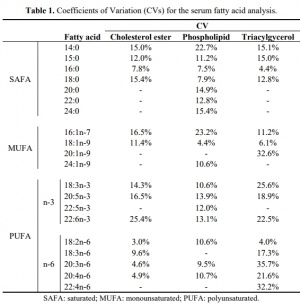Difference between revisions of "Energy Metabolism"
(→Triglycerides) |
|||
| Line 6: | Line 6: | ||
[[Image:Serum-Fatty-Acids-4.jpg|thumb|right|Table 3; Range, mean and percentiles of fatty acid concentrations (μmol/L) of plasma total lipids [https://www.ncbi.nlm.nih.gov/pmc/articles/PMC4326172/ © Abdelmagid, S.A. et al]]] | [[Image:Serum-Fatty-Acids-4.jpg|thumb|right|Table 3; Range, mean and percentiles of fatty acid concentrations (μmol/L) of plasma total lipids [https://www.ncbi.nlm.nih.gov/pmc/articles/PMC4326172/ © Abdelmagid, S.A. et al]]] | ||
| − | == | + | ==Fat== |
Plasma is composed of all major circulating lipid species including triglycerides, phospholipids, cholesterol-esters and free fatty acids.[https://www.ncbi.nlm.nih.gov/pmc/articles/PMC2918509/] | Plasma is composed of all major circulating lipid species including triglycerides, phospholipids, cholesterol-esters and free fatty acids.[https://www.ncbi.nlm.nih.gov/pmc/articles/PMC2918509/] | ||
Revision as of 17:33, 5 September 2017
The 3 main sources of energy in your body are fatty acids, sugars and protein (disregarding alcohol).
Serum Energy


Fat
Plasma is composed of all major circulating lipid species including triglycerides, phospholipids, cholesterol-esters and free fatty acids.[1]
Triglycerides (triacylglycerol) are the main constituents of adipose tissue (body fat) in humans. 25% of the molecules in triglycerides are glycerol, and 75% fatty acids. Due to glycerol's (relative to fatty acids') low molecular weight (92.094 g/mol) and caloric value (4.31 kcal/g [2]], glycerol may account for about 2% of total caloric value of triglycerides, depending on the length of the specific fatty acids. Fatty acid levels in adipose tissue reflect intake in years.[3] Serum fatty acids reflect intake in weeks.[4]
Mean total serum fatty acid levels may be 6948 μmol/L (mean molar mass 276.4 g/mol)[5] corresponding to about 192 mg/dl. That is about 10 gram per adult human, with a standard deviation of 2.6 gram.
About 2 to 5% of serum fatty acids are free fatty acids. Serum reference levels for free fatty acids are 0.00-0.72 mmol/L.[6] / with a mean value of 7.5 nM (with a standard deviation of 2.5 nM), and a 1.5 nM increase after overnight fasting. [7]
Activities
Fasting
During starvation, utilisation of fatty acids from intracellular lipid droplets is increased, and autophagy mediated.[8]
Exercise
Not just daily exercise increases lipolysis in general [9], but also acute exercise increases lipolysis, specifically in the liver (not in skeletal muscle), accompanied by increased serum levels of free fatty acid, glycerol and ketone body.[10]
Better fitness is not associated with lower dietary fat intakes.[11] Increased physical activity reduces serum triglyceride levels.[12] At similar levels mean VO2, tennis match play relies more on glycolysis and glycogenolysis compared to continuous running exercise.[13]